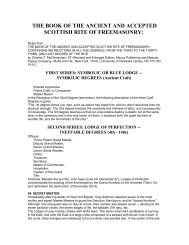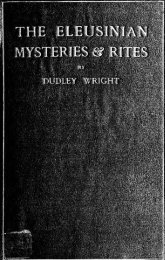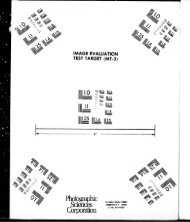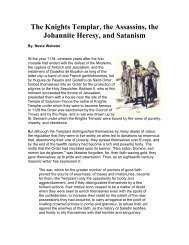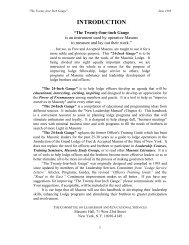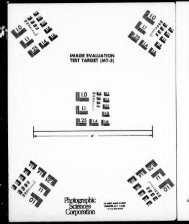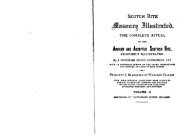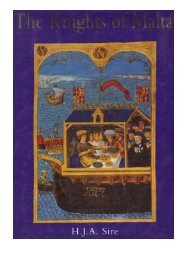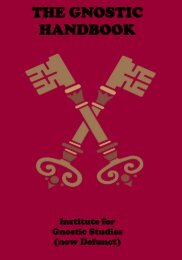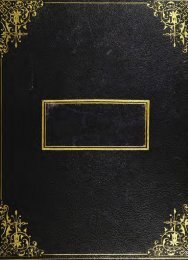The History of Initiation - The Masonic Trowel
The History of Initiation - The Masonic Trowel
The History of Initiation - The Masonic Trowel
Create successful ePaper yourself
Turn your PDF publications into a flip-book with our unique Google optimized e-Paper software.
138 HISTORY OF INITIATION<br />
<strong>The</strong> Welsh triads contain a hint <strong>of</strong> this<br />
solitary confinement<br />
in the cromlech when speaking <strong>of</strong> the initiation <strong>of</strong><br />
Arthur, who is there said to have been imprisoned "three<br />
nights in the inclosure <strong>of</strong> Oeth arid Anoeth, and three<br />
nights with the lady <strong>of</strong> Pendragon, and three nights in<br />
the prison <strong>of</strong> Kud, under the flat stone <strong>of</strong> Echemeint ;<br />
and one youth released him from the three prisons, namely,<br />
20<br />
Goreu, the son <strong>of</strong> Cystenin, his nephew." <strong>The</strong> last <strong>of</strong><br />
these prisons was evidently the cromlech, in which<br />
it is certain the candidate endured a confinement <strong>of</strong><br />
much more extended duration, 21 before he was admitted<br />
to the last and most distinguished privilege <strong>of</strong> Druidism.<br />
When the sanctuary was prepared for the solemn<br />
business <strong>of</strong> initiation, the Druids and their attendants,<br />
ceremonially arranged; properly clothed, crowned with<br />
ivy and protected by amulets ; a hymn to the sun was<br />
in a place <strong>of</strong> light.<br />
It was further symbolical <strong>of</strong> Noah,' who entered<br />
into the Ark in one year ; remained inclosed a year, and was emanci-<br />
pated from his confinement, or reborn, in the third year.<br />
Much con-<br />
fusion arose in the mythology <strong>of</strong> the ancient world from this doctrine.<br />
<strong>The</strong> aspirant, like Noah, is supposed to have lived in the old<br />
world, and was hence esteemed a venerable old man ; but he was<br />
new-born from the mysteries, as Noah was from the Ark, and hence<br />
he was considered but an infant. Noah built the Ark, and it was<br />
consequently represented as his daughter ; but he was united with<br />
the Ark, and they together floated over the all-pervading wave;<br />
hence she was taken for his wife ; and ultimately he was born from<br />
the Ark, which, from this circumstance, sustained the character <strong>of</strong><br />
his mother. Again, when he is said to die, the Ark is his c<strong>of</strong>fin ;<br />
when a child, it is his cradle ; and when he is supposed to sleep in<br />
deep repose during the prevalence <strong>of</strong> the waters, it is his bed. (Vid.<br />
Fab. Pag. Idol., vol. ii., p. 281.) <strong>The</strong> confusion this would necessarily<br />
create could not be reconciled without having recourse to a<br />
multiplication <strong>of</strong> deities, and therefore in Greece, as the father <strong>of</strong> the<br />
female principle or Ark, Noak was termed Saturn; as her husband<br />
he was termed Jupiter, and as her son, Bacchus ; and when the solar<br />
and the arkite superstitions were connected, he became Apollo, and<br />
soon branched <strong>of</strong>f into a number <strong>of</strong> collateral deities which peopled<br />
their imaginary heaven, and tended to mystify their system <strong>of</strong> reli-<br />
gion, and place it entirely out <strong>of</strong> the reach <strong>of</strong> ordinary comprehension;<br />
and the unravelment <strong>of</strong> this intricate machinery formed<br />
one grand secret <strong>of</strong> the Greater Mysteries, in which the hierophaut<br />
reduced all the complicated pantheon <strong>of</strong> idolatry to one single god.<br />
(Cudworth, Intel. Syst., 1. i., c. 4.) This subject is also handled at<br />
length in Faber's Pagan Idolatry, (b. i., c. 1, s. 10-12.)<br />
20 Welsh Archaeol. Triad. 50. Dav. Druid, p. 404.<br />
21 Welsh Archaeol., vol. i., p. 19.



